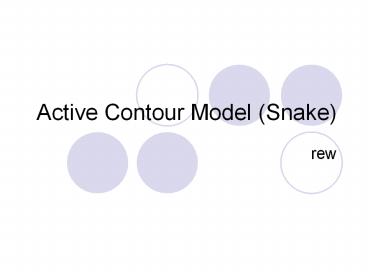Active Contour Model (Snake) - PowerPoint PPT Presentation
1 / 10
Title:
Active Contour Model (Snake)
Description:
The shape of many objects is not easily ... The constant a controls the tension along the spine. ... The constant controls the rigidity of the spine ... – PowerPoint PPT presentation
Number of Views:452
Avg rating:3.0/5.0
Title: Active Contour Model (Snake)
1
Active Contour Model (Snake)
- rew
2
Outline
- Introduce Active Contour Model
3
Active Contour Model
- First introduced by Kass, Witkin, and
Terzopoulos1987
4
Why snake?
- The shape of many objects is not easily
represented by rigid primitives. - Natural objects, such as bananas, have similar
recognizable shapes. But no two bananas are
exactly the same. - In medical imaging, objects are similar but not
exact. An exact representation of a vein's shape,
for example, cannot be given. - Some objects, such as lips, change over time.
5
Whats snake?
- Optimization technique
- Based on a spline
- Minimization the energies of the spline
- Deforms to fit local minima
- Local, not global, so initial location must be
provided
6
Whats snake?
- Customizable
- Initialization
- Weights
- User constraints
7
Energy of Snake
- A snake is defined as an energy function. To find
the best fit between a snake and an object's
shape, we minimize the energy. - Where the snake is parametrically defined as
v(i) (x(i),y(i)) - Einternal Internal spline energy caused by
stretching and bending. - Eimage Measure of the attraction of image
features such as contours. - Econstraint Measure of external constrains
either from higher level shape information or
user applied energy.
8
Internal Energy
- The internal energy provides a smoothness
constraint. - a(i) is a measure of the elasticity of the snake.
- ß(i) is a measure of the stiffness of the
snake. - The first order term makes the snake act like a
membrane - The constant a controls the tension along the
spine. - The second order term makes the snake act like a
thin plate - The constant ß controls the rigidity of the
spine - If ß0 then the function is discontinuous in its
tangent, i.e. it may develop a corner at that
point. - If aß0 then this also allows a break in the
contour, a positional discontinuity.
9
Image Energy
- The image energy is derived from the image data.
- where ? is an appropriate weighting function.
- line functional is defined simply by the image
function, - The edge functional is defined by
- the termination functional allows terminations
(i.e. free ends of lines) or corners to attract
the snake.
10
Constraint Energy
- The constraint energy is determined by external
constraints. - This energy may come in the form of a spring
attached by the user. Or, the constraint energy
may come from higher knowledge about the images
in question.

